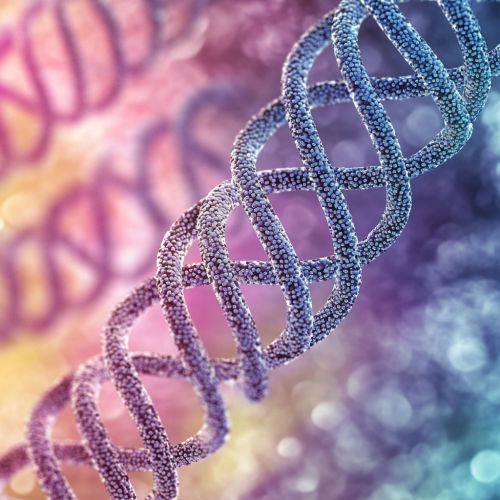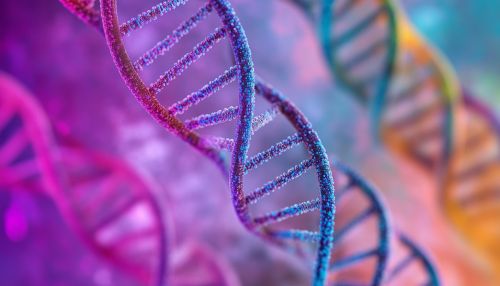DNA Methylation and Aging: Difference between revisions
No edit summary |
No edit summary |
||
| Line 27: | Line 27: | ||
In contrast to global hypomethylation, certain regions of the genome become hypermethylated with age. This site-specific hypermethylation often occurs at the promoters of tumor suppressor genes, leading to their silencing. The aberrant methylation of these genes is a hallmark of many age-related diseases, including cancer. | In contrast to global hypomethylation, certain regions of the genome become hypermethylated with age. This site-specific hypermethylation often occurs at the promoters of tumor suppressor genes, leading to their silencing. The aberrant methylation of these genes is a hallmark of many age-related diseases, including cancer. | ||
[[Image:Detail-98301.jpg|thumb|center|A close-up image of DNA strands with visible methyl groups attached, set against a background that suggests aging, such as a gradient from vibrant to faded colors.]] | [[Image:Detail-98301.jpg|thumb|center|A close-up image of DNA strands with visible methyl groups attached, set against a background that suggests aging, such as a gradient from vibrant to faded colors.|class=only_on_mobile]] | ||
[[Image:Detail-98302.jpg|thumb|center|A close-up image of DNA strands with visible methyl groups attached, set against a background that suggests aging, such as a gradient from vibrant to faded colors.|class=only_on_desktop]] | |||
== The Epigenetic Clock == | == The Epigenetic Clock == | ||
Latest revision as of 21:38, 8 October 2024
Introduction
DNA methylation is an epigenetic mechanism involving the addition of a methyl group to the DNA molecule, typically at the cytosine base of a cytosine-guanine dinucleotide (CpG site). This biochemical process plays a crucial role in regulating gene expression and maintaining genomic stability. As organisms age, DNA methylation patterns undergo significant changes, which have been implicated in the aging process and age-related diseases. This article explores the intricate relationship between DNA methylation and aging, delving into the mechanisms, implications, and current research in this field.
Mechanisms of DNA Methylation
DNA methylation primarily occurs at CpG islands, which are regions rich in cytosine and guanine nucleotides. The process is catalyzed by a family of enzymes known as DNA methyltransferases (DNMTs), including DNMT1, DNMT3A, and DNMT3B. DNMT1 is responsible for maintaining methylation patterns during DNA replication, while DNMT3A and DNMT3B are involved in de novo methylation, establishing new methylation patterns during development.
Maintenance Methylation
Maintenance methylation ensures that methylation patterns are faithfully copied during cell division. DNMT1 recognizes hemimethylated DNA, where only one strand of the DNA is methylated, and adds a methyl group to the newly synthesized strand. This process is crucial for preserving the epigenetic information across generations of cells.
De Novo Methylation
De novo methylation occurs primarily during embryonic development and is essential for cellular differentiation. DNMT3A and DNMT3B establish new methylation marks on previously unmethylated DNA, contributing to the regulation of gene expression necessary for the development of different cell types.
Changes in DNA Methylation with Aging
As organisms age, global DNA methylation patterns undergo significant alterations. These changes can be categorized into two main types: global hypomethylation and site-specific hypermethylation.
Global Hypomethylation
Global hypomethylation refers to a decrease in overall methylation levels across the genome. This phenomenon is associated with genomic instability, as it can lead to the reactivation of transposable elements and the loss of imprinting. Hypomethylation is also linked to the activation of oncogenes, contributing to the increased risk of cancer with age.
Site-Specific Hypermethylation
In contrast to global hypomethylation, certain regions of the genome become hypermethylated with age. This site-specific hypermethylation often occurs at the promoters of tumor suppressor genes, leading to their silencing. The aberrant methylation of these genes is a hallmark of many age-related diseases, including cancer.


The Epigenetic Clock
The concept of the epigenetic clock is based on the observation that specific DNA methylation patterns correlate with chronological age. This clock, also known as the Horvath clock, utilizes the methylation status of a set of CpG sites to estimate biological age. The epigenetic clock has become a valuable tool in aging research, providing insights into the biological processes underlying aging and the potential for interventions to extend healthspan.
Applications of the Epigenetic Clock
The epigenetic clock has several applications, including the assessment of biological age, prediction of lifespan, and evaluation of age-related disease risk. It is also used to study the effects of lifestyle factors, such as diet and exercise, on aging. Researchers are exploring the potential of the epigenetic clock to monitor the efficacy of anti-aging interventions and to identify biomarkers for early detection of age-related diseases.
DNA Methylation and Age-Related Diseases
Changes in DNA methylation patterns are implicated in various age-related diseases, including cancer, cardiovascular diseases, and neurodegenerative disorders. The dysregulation of methylation can lead to the aberrant expression of genes involved in these conditions.
Cancer
Age is a significant risk factor for cancer, and alterations in DNA methylation play a critical role in tumorigenesis. Hypermethylation of tumor suppressor gene promoters and global hypomethylation contribute to cancer development and progression. Understanding the methylation changes associated with cancer can aid in the development of diagnostic and therapeutic strategies.
Cardiovascular Diseases
DNA methylation changes are also linked to cardiovascular diseases, such as atherosclerosis and hypertension. Methylation alterations in genes involved in lipid metabolism, inflammation, and vascular function contribute to the pathogenesis of these conditions. Research is ongoing to identify methylation biomarkers for early detection and risk assessment of cardiovascular diseases.
Neurodegenerative Disorders
Neurodegenerative disorders, including Alzheimer's disease and Parkinson's disease, are associated with age-related changes in DNA methylation. Aberrant methylation of genes involved in neuronal function and synaptic plasticity contributes to the pathophysiology of these disorders. Epigenetic therapies targeting methylation changes hold promise for the treatment of neurodegenerative diseases.
Research and Future Directions
The study of DNA methylation and aging is a rapidly evolving field, with ongoing research aimed at understanding the mechanisms underlying methylation changes and their implications for aging and disease. Advances in sequencing technologies and bioinformatics have facilitated the comprehensive analysis of methylation patterns, providing new insights into the epigenetic regulation of aging.
Potential Interventions
Researchers are exploring various interventions to modulate DNA methylation and potentially extend healthspan. These include dietary modifications, pharmacological agents, and lifestyle interventions. Compounds such as resveratrol, curcumin, and epigallocatechin gallate (EGCG) have been shown to influence DNA methylation and are being investigated for their anti-aging properties.
Challenges and Considerations
Despite the promising potential of targeting DNA methylation for aging interventions, several challenges remain. The complexity of the epigenome and the context-dependent effects of methylation changes pose significant hurdles. Additionally, the long-term effects and safety of interventions targeting DNA methylation need to be thoroughly evaluated.
Conclusion
DNA methylation is a key epigenetic mechanism that undergoes significant changes with aging. These alterations contribute to the aging process and the development of age-related diseases. Understanding the complex relationship between DNA methylation and aging holds promise for the development of interventions to promote healthy aging and extend lifespan. Ongoing research in this field continues to uncover the intricate mechanisms underlying methylation changes and their implications for human health.
